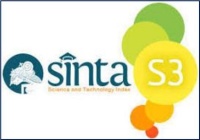Diversity and Potential Active Compound of the Sponge-Associated Bacteria from Lemukutan Island, West Kalimantan Indonesia as New Type of Antibiotics
Abstract
This study aims to determine the diversity of sponge symbiont bacteria and the effectiveness of active compounds of bacteria that are symbiotic with marine sponges from Lemukutan Island waters. The methods in this study are isolation of sponge symbiont bacteria, characterization of sponge symbiont bacteria, antagonistic tests, activity tests of the best sponge symbiont bacterial isolate extract culture filtrate, and GCMS/MS tests. The results showed that nineteen isolates of sponge symbiont bacteria were successfully isolated from sponge types from Theonella cylindrica and Hyattella intestinalis sponges in Lemukutan waters. Seven isolates of sponge symbiont bacteria are included in the Gram-positive bacteria genre. While the other twelve are included in Gram-negative bacteria. Ten of the nineteen isolates of sponge symbiont bacteria have antibacterial activity for S. aureus. Isolate Sp4 10-6 B, based on the results of antagonistic tests, has an inhibition diameter of 10.28 mm, which is categorized as solid inhibition. Ethyl acetate extract of Sp4 10-6 culture filtrate has a minimum inhibitory concentration value of 0.5% against pathogenic bacteria S.aureus. The active compound with the potential for antibiotic development is the Tetradecane compound, which has the highest peak area of the eight other types of compounds. This shows that the concentration of the compound contained is higher than the other compounds. This compound is included in the aliphatic hydrocarbon and alkane groups.
Keywords
Full Text:
PDFReferences
Fitriani A, Herdiansyah SA. (2016). Research Article Detection of Nonribosomal Peptide Synthetase (NRPS) Genes on Bacterial Endophytes from, 36(21), 124–128.
Guzii AG, Makarieva TN, Fedorov SN, Menshov AS, Denisenko VA, Popov RS, Yurchenko EA, Menchinskaya ES, Grebnev BB, Iarotsckaia VV. (2022). Toporosides A and B, Cyclopentenyl-Containing ω-Glycosylated Fatty Acid Amides, and Toporosides C and D from the Northwestern Pacific Marine Sponge Stelodoryx toporoki. J. Nat. Prod. 85 : 1186 - 1191.
Hayes S, Taki AC, Lum KY, Byrne JJ, White JM, Ekins MG, Gasser RB, Davis RA. (2022). Identification of Anthelmintic Bishomoscalarane Sesterterpenes from the Australian Marine Sponge Phyllospongia bergquistae and Structure Revision of Phyllo- lactones A–D. J. Nat. Prod. 85 : 1723 – 1729.
Holland DC, Kiefel MJ, Carroll AR. (2020). Structure Revisions of the Sponge-Derived Dibrominated Bis-Indole Alkaloids, Echi- nosulfone a and the Echinosulfonic Acids A to D. J. Org. Chem. 85 : 3490 – 3496.
Kurimoto SI, Suzuki S, Ueno M, Fromont J, Kobayashi J, Kubota T. (2020). Zamamiphidins B and C, Manzamine-Related Alkaloids from an Amphimedon sp. Marine Sponge Collected in Okinawa. J. Nat. Prod. 85 : 2226 - 2231.
Li F, Pandey P, Janussen D, Chittiboyina AG, Ferreira D, Tasdemir D. (2020). Tridiscorhabdin and Didiscorhabdin, the First Discorhabdin Oligomers Linked with a Direct C–N Bridge from the Sponge Latrunculia biformis Collected from the Deep Sea in Antarctica. J. Nat. Prod. 83 : 706 – 713.
Luo X, Wang Q, Tang X, Xu J, Wang M, Li P, Li G. (2020). Cytotoxic Manoalide-Type Sesterterpenes from the Sponge Luffariella variabilis Collected in the South China Sea. J. Nat. Prod. 84 : 61–70.
Maeyama Y, Nakashima Y, Kato H, Hitora Y, Maki K, Inada N, Murakami S, Inazumi T, Ise Y, Sugimoto Y. (2021). Amakusamine from a Psammocinia sp. Sponge Isolation Synthesis,and SAR Study on the Inhibition of RANKL-Induced Formation of Multinuclear Osteoclasts. J. Nat. Prod. 84 : 2738-2743.
Migue M, Gegunde S, Jennings LK, Genta Jouve G, Calabro K, Alfonso A, Botana LM, Thomas OP. (2020). Futunamine, a Pyrrole–Imidazole Alkaloid from the Sponge Stylissa aff. carteri Collected off the Futuna Islands. J. Nat. Prod. 83 : 2299 - 2304.
Mioso R, Marante F, Bezerra R, Borges F, Santos B, Laguna I. (2017). Cytotoxic Compounds Derived from Marine Sponges. 22 (2): 1- 34.
Mohan R, Sivakumar V, Rangasamy T, Muralidharan C. (2016). Optimisation of bromelain enzyme extraction from pineapple (Ananas comosus) and application in process industry. American Journal of Biochemistry and Biotechnology. 12(3), 188–195.
Moosmann P, Taniguchi T, Furihata K, Utsumi H, Ise Y, Morii Y, Yamawaki N, Takatani T, Arakawa O, Okada S. (2021). Myrindole A, an Antimicrobial Bis-Indole from a Marine Sponge Myrmekioderma sp. Org. Lett. 23 : 3477 – 3480.
Narayana KJP, Prabhakar P, Vijayalakshmi M, Venkateswarlu Y, Krishna P. (2018). Study on bioactive compounds from Streptomyces sp. ANU 277. Polish J Microbiol. 57(1):35–39.
Sadahiro Y, Hitora Y, Fukumoto A, Ise Y, Angkouw ED, Mangindaan REP, Tsukamoto S. (2020). Melophluosides A and B, New Triterpene Galactosides from the Marine Sponge Melophlus sarasinorum. Tetrahedron Lett. 61 : 151852.
Sari DM, Effendi I, Nursyirwani N. (2019). Identification of Antibiotic-Producing Bacteria from Extreme Microhabitat in Molecular Mangrove Ecosystems and Their Activity on Pathogenic Bacteria (Vibrio alginolyticus). Jurnal Perikanan dan Kelautan, 9 (2): 137.
Tamura V, Suseela M. Simpson B, Powell N. (2017). Tharayil Plant litter Chemistry Alters The Content And Composition Of Organic Carbon Associated With Soil Mineral And Aggregate Fractions In Invaded Ecosystems. Global Change Biology. 23 : 4002-4018.
Tarazona G, Fernández R, Pérez M, Millán RE, Jiménez C, Rodríguez J, Cuevas C. (2022). Enigmazole C: A Cytotoxic Macrocyclic Lactone and Its Ring-Opened Derivatives from a New Species of Homophymia Sponge. J. Nat. Prod. 85 : 1059 - 1066.
Wang Q, Sun Y, Yang L, Luo X, de Voogd NJ, Tang X, Li P, Li G. (2020) Bishomoscalarane Sesterterpenoids from the Sponge Dysidea granulosa Collected in the South China Sea. J. Nat. Prod. 83 : 516 - 523.
Yu HB, Hu B, Wu GF, Ning Z, He Y, Jiao BH, Liu XY, Lin HW. (2023). Phyllospongianes A–E, Dinorscalarane Sesterterpenes from the Marine Sponge Phyllospongia foliascens. J. Nat. Prod. 86 : 1754 – 1760.
DOI: https://doi.org/10.33394/bioscientist.v13i2.14660
Refbacks
- There are currently no refbacks.

This work is licensed under a Creative Commons Attribution-ShareAlike 4.0 International License.

Bioscientist : Jurnal Ilmiah Biologi is licensed under a Creative Commons Attribution-ShareAlike 4.0 International License
Editorial Address: Pemuda Street No. 59A, Catur Building Floor I, Mataram City, West Nusa Tenggara Province, Indonesia











